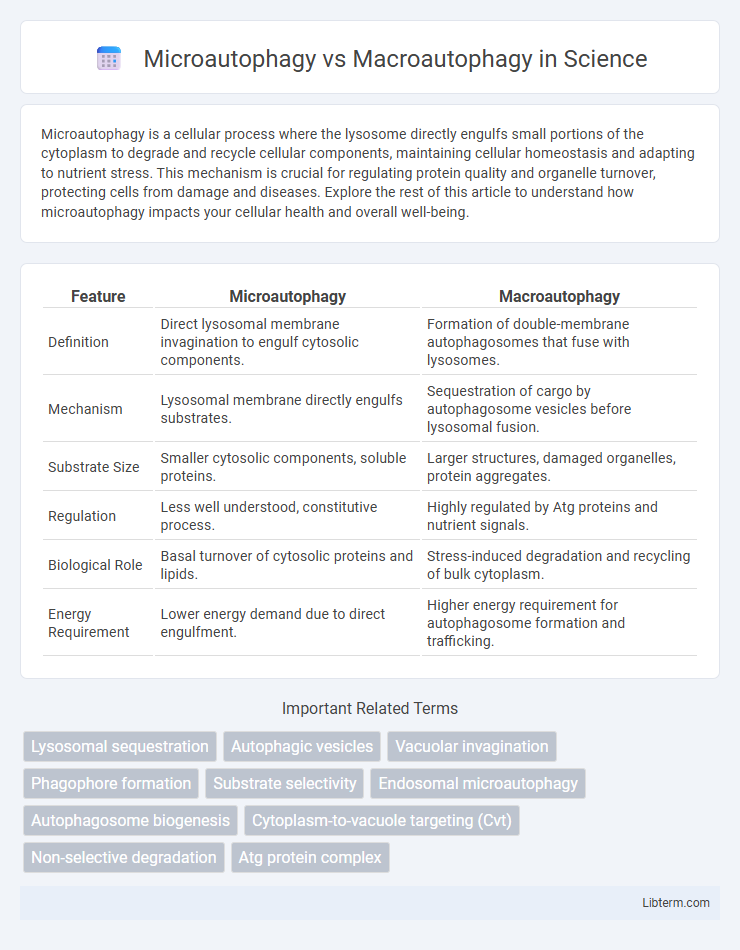Microautophagy is a cellular process where the lysosome directly engulfs small portions of the cytoplasm to degrade and recycle cellular components, maintaining cellular homeostasis and adapting to nutrient stress. This mechanism is crucial for regulating protein quality and organelle turnover, protecting cells from damage and diseases. Explore the rest of this article to understand how microautophagy impacts your cellular health and overall well-being.
Table of Comparison
| Feature | Microautophagy | Macroautophagy |
|---|---|---|
| Definition | Direct lysosomal membrane invagination to engulf cytosolic components. | Formation of double-membrane autophagosomes that fuse with lysosomes. |
| Mechanism | Lysosomal membrane directly engulfs substrates. | Sequestration of cargo by autophagosome vesicles before lysosomal fusion. |
| Substrate Size | Smaller cytosolic components, soluble proteins. | Larger structures, damaged organelles, protein aggregates. |
| Regulation | Less well understood, constitutive process. | Highly regulated by Atg proteins and nutrient signals. |
| Biological Role | Basal turnover of cytosolic proteins and lipids. | Stress-induced degradation and recycling of bulk cytoplasm. |
| Energy Requirement | Lower energy demand due to direct engulfment. | Higher energy requirement for autophagosome formation and trafficking. |
Introduction to Autophagy: An Overview
Autophagy is a cellular degradation process essential for maintaining homeostasis by recycling cytoplasmic components. Microautophagy involves the direct engulfment of cytoplasmic material by lysosomes through membrane invagination, while macroautophagy relies on the formation of double-membraned autophagosomes that sequester cargo before fusing with lysosomes. Both pathways are critical for cellular quality control and adaptation to nutrient stress, but macroautophagy is typically more versatile in targeting larger organelles and protein aggregates.
Defining Microautophagy and Macroautophagy
Microautophagy is a cellular degradation process where the lysosome directly engulfs small portions of cytoplasm through invagination, membrane protrusion, or septation, enabling selective and non-selective recycling of cellular components. Macroautophagy involves the formation of double-membrane vesicles called autophagosomes that sequester large cytoplasmic cargo, which then fuse with lysosomes to facilitate bulk degradation and recycling. Both processes maintain cellular homeostasis but differ distinctly in mechanisms of cargo recognition, sequestration, and transport to lysosomes.
Cellular Mechanisms of Microautophagy
Microautophagy involves the direct engulfment of cytoplasmic material by lysosomal membrane invagination, leading to the formation of vesicles that sequester substrates for degradation. This process relies on lysosomal membrane dynamics and does not require the formation of autophagosomes, distinguishing it from macroautophagy, which utilizes double-membraned autophagosomes for cargo sequestration. The selectivity and regulation of microautophagy depend on specific receptors and membrane proteins that mediate substrate recognition and vesicle scission within the lysosomal compartment.
Cellular Mechanisms of Macroautophagy
Macroautophagy involves the formation of double-membrane vesicles called autophagosomes that engulf cytoplasmic components and deliver them to lysosomes for degradation, whereas microautophagy directly sequesters cytoplasmic material through lysosomal membrane invagination. The initiation of macroautophagy is regulated by ULK1 kinase complex activation, followed by nucleation of the phagophore mediated by the class III PI3K complex. Expansion and closure of the autophagosome require ATG proteins and lipidation of LC3, ensuring selective cargo sequestration and subsequent fusion with lysosomes for degradation and recycling of cellular constituents.
Key Molecular Players in Microautophagy
Microautophagy involves the direct engulfment of cytoplasmic components by lysosomal membrane invagination, primarily regulated by key molecular players such as the Endosomal Sorting Complex Required for Transport (ESCRT) machinery, vacuolar H+-ATPase, and phospholipid remodelers. Unlike macroautophagy, which relies on autophagosome formation orchestrated by ATG proteins like ULK1 and Beclin-1, microautophagy depends on distinct lysosomal membrane dynamics and associated proteins including Vps27 and Vps23. These molecules coordinate membrane deformation and cargo selection, ensuring selective degradation within the lysosome.
Key Molecular Players in Macroautophagy
Macroautophagy relies on key molecular players such as the ULK1 complex, which initiates autophagosome formation, and the class III PI3K complex responsible for nucleation of the isolation membrane. ATG proteins, including ATG5-ATG12 conjugation system and LC3 lipidation, orchestrate the elongation and closure of the autophagosome. These molecular components work together to ensure selective degradation of cytoplasmic material, contrasting microautophagy, which involves direct lysosomal membrane invagination without autophagosome formation.
Physiological Functions and Roles
Microautophagy involves the direct engulfment of cytoplasmic components by lysosomes, primarily contributing to the selective degradation of small proteins and maintaining cellular homeostasis during nutrient stress. Macroautophagy encapsulates large portions of cytoplasm, including damaged organelles and protein aggregates, in double-membrane autophagosomes for delivery to lysosomes, playing a crucial role in quality control, energy regulation, and cell survival under metabolic stress. Both pathways coordinate to regulate intracellular turnover, support adaptation to changing environmental conditions, and prevent the accumulation of dysfunctional cellular components linked to diseases.
Major Differences Between Microautophagy and Macroautophagy
Microautophagy involves the direct engulfment of cytoplasmic material by lysosomal membrane invagination, whereas macroautophagy sequesters cargo within double-membrane vesicles called autophagosomes before lysosomal fusion. The scale and selectivity differ, with macroautophagy capable of degrading larger structures such as organelles, while microautophagy primarily targets smaller cytosolic components. Regulatory pathways also vary, as macroautophagy is extensively controlled by ATG proteins and energy-sensing kinases like mTOR, contrasting with microautophagy's less understood but more constitutive activity.
Relevance in Disease and Therapeutic Potential
Microautophagy and macroautophagy are critical cellular degradation pathways influencing disease progression and treatment strategies. Macroautophagy involves the formation of autophagosomes that sequester cytoplasmic components, playing a crucial role in neurodegenerative disorders like Parkinson's and Alzheimer's disease by clearing aggregated proteins. Microautophagy, characterized by direct lysosomal membrane invagination for substrate uptake, demonstrates therapeutic potential in cancer by regulating cellular metabolism and maintaining cellular homeostasis under stress conditions.
Future Perspectives in Autophagy Research
Emerging research highlights the therapeutic potential of targeting both microautophagy and macroautophagy pathways to treat neurodegenerative diseases and cancer. Advanced imaging techniques and single-cell analysis are poised to unravel precise molecular mechanisms and regulatory networks within these autophagic processes. Integration of multi-omics data will accelerate the discovery of autophagy modulators, paving the way for personalized medicine and novel drug development in autophagy-related disorders.
Microautophagy Infographic

 libterm.com
libterm.com